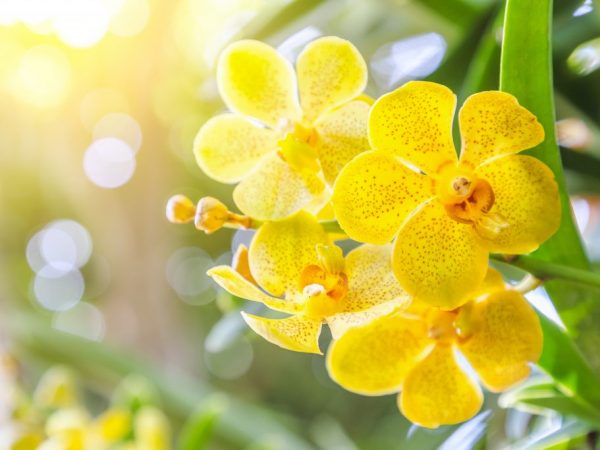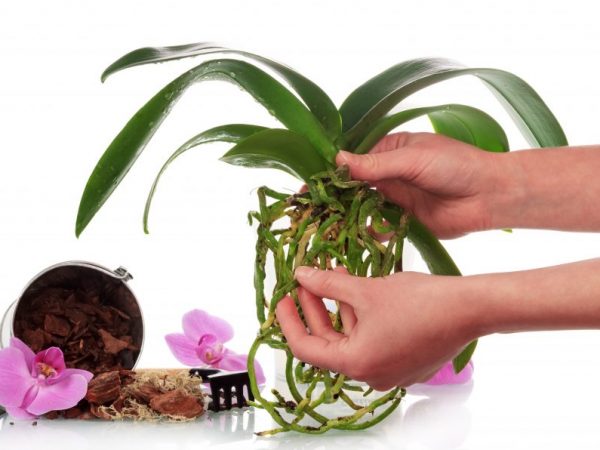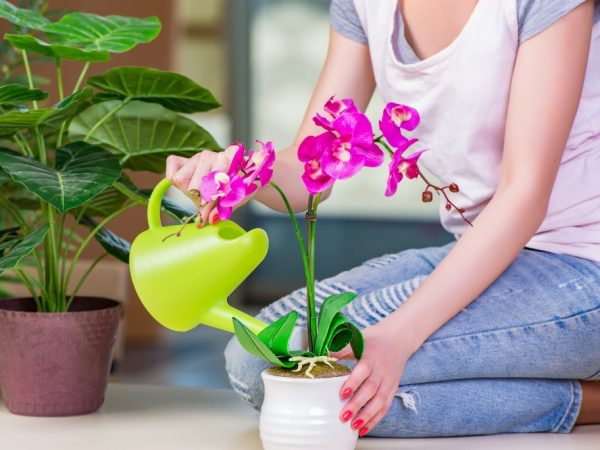How to help an orchid with dry roots
Most orchids are known to be capricious, therefore they require increased attention from the grower. A common problem is orchid roots dry and wither. To save a flower from death requires decisive action.

How to help an orchid with dry roots
Causes of drying orchid roots
Orchid roots dry out for several reasons. All of them are associated with mistakes made by the florist when caring for the plant. The main reason is insufficient watering. When the soil is dry, the plant does not receive nutrition and slowly dies. The flower should be rescued only in case of ineffectiveness of extraordinary soil moistening.
Dry roots in an orchid can also be from getting them a chemical burn as a result of the introduction of hard water and fertilizers. Hard water contains a high concentration of metals and salts, which can negatively affect the health of the flower's root system. An overdose of fertilizer has the same effect. If the roots have dried out for this reason, their surface should be covered with a brown bloom, and the soil should be pulled together by a white crust.
Another possible problem is a decrease in the humidity level in the room where the plant is grown. For its normal development, 50-60% humidity is required. In winter, during the period of active operation of the heating system, this figure drops to 20-25%, which is why the root system dries up. The unfavorable air temperature has the same negative effect. Its indicator should not fall below 18 ° С and rise above 28 ° С.
Orchid roots also wither from injuries and infectious diseases. Under such conditions, it is also important to take timely measures to avoid the death of the flower. You will need to organize effective treatment, transplant the flower into new soil and carefully follow the care recommendations.
Signs of an orchid problem
Due to the peculiarities of development, it is not difficult to identify problems with the root system in a timely manner. It does not dry out asymptomatically: the lethargy of the peduncle and leaves indicates the problem. The leaves dry out, lose their turgor, especially during the dormant period.
Another sign is the active formation of the aerial root system. In epiphytic plants, the appearance of 1-3 root shoots above the ground is the norm, but when the roots of an orchid dry out due to a lack of moisture or problems with temperature conditions, most of them rush upward, outside the soil.

It is important to identify problems with the root system in a timely manner.
The upper sections of the root system can sprout in different directions, trying to find access to water. If up, they lack oxygen. Without help, they become dry and light. Such external features indicate that the roots have already dried up.
How to revive the roots of a plant
If the roots of an orchid dry out, it is important to save the remaining living areas that can give impetus to the development of a new root system. If the flower begins to dry out, the affected areas are identified and removed.The florist should:
- gently remove the flower from the pot;
- remove the peduncle and yellowed leaves;
- check the viability of the root system: the plant is placed in water for several hours; roots that have not dried up will be hard, and sluggish ones - empty inside - when palpating the affected areas, the softness of the tissues will be felt.
After inspection, the dried roots are removed, and the plant itself is treated with phytosporin to prevent infection with fungal infections. The solution is prepared in a proportion of 6-8 drops of the product per 200 ml of water. The flower is placed in a container with medicine, kept there for 6-8 hours, taken out and dried. The tips of the remaining roots are treated with crushed activated carbon.
To revive the flower, you need daily baths in water at room temperature for 2-3 hours. Not the whole orchid is placed in the water, but only its root section. To maintain the plant's viability for the remaining time, it is placed on top of a container of water.
If the roots of the orchid continue to dry, the schedule of water procedures is changed. Keeping the pot in water with daily air baths for 2-3 hours helps to save the flower. If the roots have begun to grow, they wait until their length reaches 4-5 cm, so that afterwards they can be transplanted to the main growing site.
If there is only one healthy root left
If the roots of the orchid are not completely dry, 1-2 roots remain unharmed, the actions will be different. The florist should:
- Cut off the peduncle (dried roots will not allow it to develop normally).
- Get rid of the affected roots and place the plant in a solution of succinic acid (4 tablets per 1 liter of water) for 2-3 hours.
- Take out the plant and dry the roots.
- Plant the flower in a new container with prepared orchid substrate.
- The flower will take down new roots if all the necessary care measures are provided to it. When keeping an orchid at home, it is important to find a suitable place for it in partial shade (the light should be diffused) and monitor the need for watering.
Preventive methods
If the roots of an orchid dry out, this is a sign of poor plant care, therefore, preventive methods are based on providing the flower with comfortable conditions.

The flower needs to be provided with comfortable conditions of detention.
Special attention is paid to:
- Choosing a pot. The container for keeping the flower is selected individually, taking into account the characteristics of the type of plant. Orchid roots can dry out when grown in tight pots and rot when used with a large container.
- Watering. The roots often dry out from insufficient watering. They monitor the condition of the soil. If it is dry, the soil is moistened. The approximate frequency of the event is once a week.
- Indicators of temperature and humidity. Providing comfortable conditions for growing a home flower affects its growth and development. To prevent the roots from becoming dry, the temperature in the room is maintained at 18 ° -25 ° C and the moderate air humidity is monitored (especially in winter). To increase the humidity, a container with water is placed next to the plant.
It is also imperative to carry out preventive spraying of the plant against fungal diseases that can damage not only its leaves, but also the root system. The most effective remedies are Fitosporin and systemic fungicides (Fundazol). Knowing all these features of flower care helps prevent orchid roots from drying out.
Conclusion
If the roots of your home orchid are dry, don't throw the plant away. It is life-loving, and even without a root system, it is able to find the strength to survive.
With the right help, you can reanimate the flower by awakening dormant buds and giving impetus to the development of a new root system.


